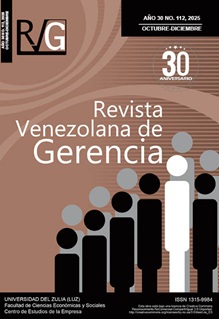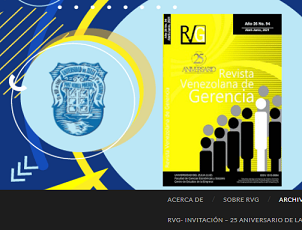Employer branding global (2014–2024): Tendencias, vacíos y perspectivas desde un análisis bibliométrico
Resumen
En la última década, el employer branding se ha consolidado como una estrategia fundamental en la gestión del talento, especialmente en entornos organizacionales marcados por la digitalización, la sostenibilidad y la transformación cultural. El objetivo de este estudio es identificar las principales tendencias, vacíos temáticos y geográficos, así como los enfoques teóricos predominantes en la literatura académica entre 2014 y 2024. La metodología consistió en un análisis bibliométrico de 778 artículos indexados en Scopus, procesados mediante el software VOSviewer para identificar redes de coautoría, clústeres temáticos y patrones de citación. Los resultados revelan una alta concentración de estudios en contextos anglosajones y asiáticos, con escasa participación latinoamericana. Desde el enfoque temático, los autores consideran que el campo ha privilegiado una visión instrumental del employer branding, en desmedro de dimensiones éticas, sostenibles y comunicacionales que resultan claves en el contexto actual. Se concluye que es necesario ampliar la agenda investigativa hacia marcos más críticos y contextualizados, incorporando también enfoques cualitativos y mixtos que permitan comprender el employer branding como un proceso estratégico con implicancias sociales y organizacionales.
Citas
Abdurrohim, A., Susanty, A. I., & Silvianita, A. (2024). Analyzing employee engagement as a mediator in the relationship between employer branding and talent retention with job burnout as a moderator: A study of international telco company based in Indonesia. International Journal For Multidisciplinary Research, 6(6). https://doi.org/10.36948/ijfmr.2024.v06i06.33576
Alves, P., Santos, V., Reis, I., Martinho, F., Martinho, D., Correia Sampaio, M., José Sousa, M., & Au-Yong-Oliveira, M. (2020). Strategic Talent Management: The Impact of Employer Branding on the Affective Commitment of Employees. Sustainability, 12(23), 9993. https://doi.org/10.3390/su12239993
Amezcua, J. B., Ruiz, A. L., y Méndez, A. (2025). Percepción de la Contribución de la Economía Colaborativa a los Objetivos de Desarrollo Sostenible. RAN. Revistas Academia y Negocios, 11(1), 1–14. https://doi.org/10.29393/RAN11-1PSAA20001
Azhar, A., Rehman, N., Majeed, N., & Bano, S. (2024). Employer branding: A strategy to enhance organizational performance. International Journal of Hospitality Management, 116, 103618. https://doi.org/10.1016/j.ijhm.2023.103618
Backhaus, K., & Tikoo, S. (2004). Conceptualizing and researching employer branding. Career Development International, 9(5), 501–517. https://doi.org/10.1108/13620430410550754
Biswas, M. K., & Suar, D. (2016). Antecedents and Consequences of Employer Branding. Journal of Business Ethics, 136(1), 57–72. https://doi.org/10.1007/s10551-014-2502-3
Blyznyuk, T., Shevchenko, V., Fedaka, V., & Tsiktor, V. (2024). Sustainability and social responsibility of human resources as a global reputation trend for competitiveness. Ukrainian Journal of Applied Economics and Technology, 9(3), 383–391. https://orcid.org/0000-0002-8291-4150
Botella-Carrubi, D., Gil-Gomez, H., Oltra-Badenes, R., & Jabaloyes-Vivas, J. M. (2021). Employer branding factors as promoters of the dimensions of employee organizational commitment. Economic Research-Ekonomska Istraživanja, 34(1), 1836–1849. https://doi.org/10.1080/1331677X.2020.1851280
Burmann, C., & Zeplin, S. (2005). Building brand commitment: A behavioural approach to internal brand management. Journal of Brand Management, 12(4), 279–300. https://doi.org/10.1057/palgrave.bm.2540223
Bussin, M., & Mouton, H. (2019). Effectiveness of employer branding on staff retention and compensation expectations. South African Journal of Economic and Management Sciences, 22(1). https://doi.org/10.4102/sajems.v22i1.2412
Choudhary, S., & Joshi, R. (2024). Unveiling the power of employer branding: enhancing talent retention through organizational advocacy. Asia-Pacific Journal of Business Administration. https://doi.org/10.1108/APJBA-04-2024-0225
Cobo, M. J., López-Herrera, A. G., Herrera-Viedma, E., & Herrera, F. (2011). An approach for detecting, quantifying, and visualizing the evolution of a research field: A practical application to the Fuzzy Sets Theory field. Journal of Informetrics, 5(1), 146–166. https://doi.org/10.1016/j.joi.2010.10.002
Dabirian, A., Paschen, J., & Kietzmann, J. (2019). Employer Branding: Understanding Employer Attractiveness of IT Companies. IT Professional, 21(1), 82–89. https://doi.org/10.1109/MITP.2018.2876980
Dhall, N., & Garg, D. (2025). Employer Branding through the lens of Bibliometrics: An Analytical Review. Effulgence-A Management Journal, 23(1), 174–186. https://doi.org/10.33601/effulgence.rdias/v23/i1/2025/174-186
Eck, N. J., & Waltman, L. (2010). Software survey: VOSviewer, a computer program for bibliometric mapping. Scientometrics, 84(2), 523–538. https://doi.org/10.1007/s11192-009-0146-3
Edwards, M. R. (2009). An integrative review of employer branding and OB theory. Personnel Review, 39(1), 5–23. https://doi.org/10.1108/00483481011012809
Escobar, A. (2019). Autonomía y diseño. Universidad del Cauca. https://doi.org/10.2307/j.ctvpv50jd
Escobar, A., & Palacio, M. F. (2024). The “great place to work” certification as an employer branding promotional startegy in the recruitment of colombian SME´s. Tendencias, 25(1), 166–190. https://doi.org/10.22267/rtend.242501.245
Escobar-Farfán, M., Salas Calfucura, J., Gálvez Lorca, M., y Miranda Vivanco, C. (2022). Propuesta de escala de personalidad de marca en la industria de supermercados en Chile. RAN. Revistas Academia y Negocios, 8(1), 23–42. https://doi.org/10.29393/RAN8-3PEMC40003
Ewing, M. T., Pitt, L. F., de Bussy, N. M., & Berthon, P. (2002). Employment branding in the knowledge economy. International Journal of Advertising, 21(1), 3–22. https://doi.org/10.1080/02650487.2002.11104914
Foster, C., Punjaisri, K., & Cheng, R. (2010). Exploring the relationship between corporate, internal and employer branding. Journal of Product y Brand Management, 19(6), 401–409. https://doi.org/10.1108/10610421011085712
Gelard, P. (2024). Identifying and Assessing Factors Affecting Employer Branding in the Banking Industry. Sage Open, 14(2). https://doi.org/10.1177/21582440241257658
Hanin, D., Stinglhamber, F., & Delobbe, N. (2013). The Impact of Employer Branding on Employees: The Role of Employment Offering in the Prediction of Their Affective Commitment. Psychologica Belgica, 53(4), 57. https://doi.org/10.5334/pb-53-4-57
Heide, M. P., Prodan, S., Lazaroiu, G., Kreis-Engelhardt, B., & Ghigiu, A.-M. (2024). Communication as a Key Performance Indicator in Employer Branding in the Context of the Social Economy—A Quantitative Study. Behavioral Sciences, 14(4), 303. https://doi.org/10.3390/bs14040303
Hoppe, D. (2018). Linking employer branding and internal branding: establishing perceived employer brand image as an antecedent of favourable employee brand attitudes and behaviours. Journal of Product y Brand Management, 27(4), 452–467. https://doi.org/10.1108/JPBM-12-2016-1374
Jiménez-Figueroa, A., Ossa-Cornejo, C. J., y Gómez-Urrutia, V. E. (2025). Teletrabajo y Conciliación Trabajo-Familia en el Sector Público: Impacto del Género y la Familia. RAN. Revistas Academia y Negocios, 11(1), 1–15. https://doi.org/10.29393/RAN11-4TCAV30004
Joyce, P. R., Selvaraj, F. J., Manoharan, G., Priya, C., Vijayalakshmi, R., Dwivedi, P. K., Gupta, S., & Veerakumar, K. (2024). To Study The Role Of Marketing In Human Resource Management. Migration Letters, 21(S2), 1191–1196. https://doi.org/10.59670/ml.v21iS2.7072
Junça, A., & Dias, H. (2023). The relationship between employer branding, corporate reputation and intention to apply to a job offer. International Journal of Organizational Analysis, 31(8), 1–16. https://doi.org/10.1108/IJOA-01-2022-3129
Kashyap, V., & Verma, N. (2018). Linking dimensions of employer branding and turnover intentions. International Journal of Organizational Analysis, 26(2), 282–295. https://doi.org/10.1108/IJOA-03-2017-1134
King, C., Grace, D., & Funk, D. C. (2013). Erratum: Employee brand equity: Scale development and validation. Journal of Brand Management, 20(4), 350–354. https://doi.org/10.1057/bm.2012.60
Klimkiewicz, K., & Oltra, V. (2017). Does CSR Enhance Employer Attractiveness? The Role of Millennial Job Seekers’ Attitudes. Corporate Social Responsibility and Environmental Management, 24(5), 449–463. https://doi.org/10.1002/csr.1419
Lievens, F. (2007). Employer branding in the Belgian Army: The importance of instrumental and symbolic beliefs for potential applicants, actual applicants, and military employees. Human Resource Management, 46(1), 51–69. https://doi.org/10.1002/hrm.20145
Lievens, F., & Slaughter, J. E. (2016). Employer Image and Employer Branding: What We Know and What We Need to Know. Annual Review of Organizational Psychology and Organizational Behavior, 3(1), 407–440. https://doi.org/10.1146/annurev-orgpsych-041015-062501
López-Rodríguez, C. E., Gómez Rodríguez, D. T., y Santana Cortés, L. O. (2025). Evolución de la Administración de Empresas: Un análisis bibliométrico desde las dinámicas de los negocios globales. RAN. Revistas Academia y Negocios, 11(1), 1–14. https://doi.org/10.29393/RAN11-10EALR30010
Maheshwari, V., Gunesh, P., Lodorfos, G., & Konstantopoulou, A. (2017). Exploring HR practitioners’ perspective on employer branding and its role in organisational attractiveness and talent management. International Journal of Organizational Analysis, 25(5), 742–761. https://doi.org/10.1108/IJOA-03-2017-1136
Maurya, K. K., & Agarwal, M. (2018). Organisational talent management and perceived employer branding. International Journal of Organizational Analysis, 26(2), 312–330. https://doi.org/10.1108/IJOA-04-2017-1147
McAllister, J. T., Lennertz, L., & Atencio, Z. (2022). Mapping A Discipline: A Guide to Using VOSviewer for Bibliometric and Visual Analysis. Science y Technology Libraries, 41(3), 319–348. https://doi.org/10.1080/0194262X.2021.1991547
Melián-González, S., & Bulchand-Gidumal, J. (2017). Why Online Reviews Matter for Employer Brand: Evidence from Glassdoor.
Minchington, B. (2010). Employer Brand Leadership: A Global Perspective. Collective Learning Australia. https://books.google.com/books/about/Employer_Brand_Leadership.html?id=oU2aSQAACAAJ
Moroko, L., & Uncles, M. D. (2008). Characteristics of successful employer brands. Journal of Brand Management, 16(3), 160–175. https://doi.org/10.1057/bm.2008.4
Mosley, R. (2014). Employer Brand Management: Practical Lessons from the World’s Leading Employers. Wiley.
Piha, L. P., & Avlonitis, G. J. (2018). Internal brand orientation: conceptualisation, scale development and validation. Journal of Marketing Management, 34(3–4), 370–394. https://doi.org/10.1080/0267257X.2018.1445658
Plata, G., Pereira, M., Lopez, M. B., y Alonzo, C. I. (2023). Estratégias de Employer Branding com enfoque na retenção de colaboradores: estudo aplicado em uma empresa de tecnologia de Florianópolis. Ciencias Económicas, 2(19), e0019. https://doi.org/10.14409/rce.2022.19.e0019
Punjaisri, K., & Wilson, A. (2007). The role of internal branding in the delivery of employee brand promise. Journal of Brand Management, 15(1), 57–70. https://doi.org/10.1057/palgrave.bm.2550110
Ramos-Rubio, J. (2025). Comunicación estratégica interna y marca empleadora: Análisis de casos en el sector salud. Revista de Ciencias Sociales Aplicadas, 10(2), 79–97.
Ramos-Rubio, P., & Bandeira-Duarte, J. (2025). Exploración del branding sonoro y su impacto en el consumidor: El caso de Apple y Samsung. RAN. Revistas Academia y Negocios, 11(1), 1–13. https://doi.org/10.29393/RAN11-8EBRB20008
Reis, I., Sousa, M. J., & Dionísio, A. (2021). Employer Branding as a Talent Management Tool: A Systematic Literature Revision. Sustainability, 13(19), 10698. https://doi.org/10.3390/su131910698
Reshma, J., & Velmurugan, G. (2024). A systematic and bibliometric analysis of employer branding research: Trends, impacts, and future directions (2004-2023). Multidisciplinary Reviews, 7(9), 2024204. https://doi.org/10.31893/multirev.2024204
Rys, M., Schollaert, E., & Van Hoye, G. (2024). Living the employer brand during a crisis? A qualitative study on internal employer branding in times of the COVID-19 pandemic. PLOS ONE, 19(5), e0303361. https://doi.org/10.1371/journal.pone.0303361
Saini, G. K. (2023). Employer Branding: A Critical Review and Future Research. NHRD Network Journal, 16(3), 220–232. https://doi.org/10.1177/26314541231170424
Saini, G. K., & Jawahar, I. M. (2019). The influence of employer rankings, employment experience, and employee characteristics on employer branding as an employer of choice. Career Development International, 24(7), 636–657. https://doi.org/10.1108/CDI-11-2018-0290
Schlager, T., Bodderas, M., Maas, P., & Luc Cachelin, J. (2011). The influence of the employer brand on employee attitudes relevant for service branding: an empirical investigation. Journal of Services Marketing, 25(7), 497–508. https://doi.org/10.1108/08876041111173624
Špoljarić, A., & Ozretić, Đ. (2023). Employer brand and international employer brand: literature review. Corporate Communications: An International Journal, 28(4), 671–682. https://doi.org/10.1108/CCIJ-11-2022-0141
Suifan, T. S., Diab, H., & Abdallah, A. B. (2017). Does organizational justice affect turnover-intention in a developing country? The mediating role of job satisfaction and organizational commitment. Journal of Management Development, 36(9), 1137–1148. https://doi.org/10.1108/JMD-02-2017-0048
Tanwar, K., & Prasad, A. (2017). Employer brand scale development and validation: a second-order factor approach. Personnel Review, 46(2), 389–409. https://doi.org/10.1108/PR-03-2015-0065
Thang, N. N., & Trang, P. T. (2024). Employer branding, organization’s image and reputation, and intention to apply: the moderating role of the availability of organizational information on social media. Frontiers in Sociology, 9. https://doi.org/10.3389/fsoc.2024.1256733
Theurer, C. P., Tumasjan, A., Welpe, I. M., & Lievens, F. (2018). Employer Branding: A Brand Equity-based Literature Review and Research Agenda. International Journal of Management Reviews, 20(1), 155–179. https://doi.org/10.1111/ijmr.12121
Tumasjan, A., Kunze, F., Bruch, H., & Welpe, I. M. (2020). Linking employer branding orientation and firm performance: Testing a dual mediation route of recruitment efficiency and positive affective climate. Human Resource Management, 59(1), 83–99. https://doi.org/10.1002/hrm.21980
Zupic, I., & Čater, T. (2015). Bibliometric Methods in Management and Organization. Organizational Research Methods, 18(3), 429–472. https://doi.org/10.1177/1094428114562629

Esta obra está bajo licencia internacional Creative Commons Reconocimiento-NoComercial-CompartirIgual 4.0.







.png)






























